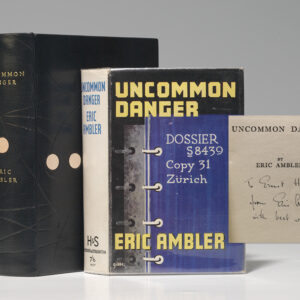Description
“I’D HAVE MADE IT MORE SEXY, IF I HAD KNOWN YOU SOONER”: EXCEPTIONAL PRESENTATION / ASSOCIATION COPY OF THE HIGH WINDOW, INSCRIBED BY RAYMOND CHANDLER TO DIRECTOR BILLY WILDER
CHANDLER, Raymond. The High Window. New York: Alfred A. Knopf, 1942. Octavo, original brown cloth, original pictorial dust jacket. Housed in custom full blue morocco gilt clamshell box.
First edition of Chandler’s scarce third novel, a rare presentation copy inscribed to director Billy Wilder upon their infamous collaboration on the screenplay for Wilder’s film noir classic, Double Indemnity, “For Billy: I’d have made it more sexy, if I had known you sooner. Ray”
By the time his third novel was published, Raymond Chandler had achieved a reputation that drew admirers from far beyond the world of pulp fiction. He “wrote to his publisher about [The High Window] that he ‘seemed to have to get the thing out of my system,’ and this obsessive need is what powers the book, turning it from a routine ‘hard-boiled’ story into something hauntingly memorable” (Crime & Mystery: 100 Best, 31). At the time Chandler also sought active participation in movie adaptations of his work; “he could see no reason why he should not be involved with the films that resulted, since they clearly needed improving.” By 1941 his novels had begun appearing on screen and in 1942 The High Window was quickly sold to Twentieth Century-Fox, but Chandler had not yet reached his goal, the chance to work as a screenwriter. His first opportunity came in mid-1943 when he “was asked to collaborate with Billy Wilder in writing the film script for James M. Cain’s Double Indemnity.” Their writing partnership would prove the decade’s most tumultuous and legendary clash of writing talents. After reading The High Window, Wilder, an established screenwriter and director, had asked his producer Joe Sistrom to seek out Chandler to co-write a planned adaptation of James M. Cain’s novel Double Indemnity (1936). Wilder later described Chandler as “‘one of the greatest creative minds’ he had encountered,” but their partnership became infamous in the hallways of Paramount’s Writers Building. Chandler “did not take easily to working in the studio” and rows with Wilder would sometimes “require the intervention of Joseph Sistrom.” Chandler went on to work on other Hollywood projects and “later said that his collaboration with Wilder ‘was an agonizing experience and has probably shortened my life; but I learned from it as much about screen writing as I am capable of learning” (MacShane, 105, 108, 107). Considered Billy Wilder’s “first and truest film noir,” the film Double Indemnity, released in April 1944, starred Fred MacMurray and Barbara Stanwyck, and was featured by Life magazine as a ‘Movie of the Week’ (Silver & Ward, 93). Critical praise and the movie’s popularity immediately established “Chandler’s reputation as a screenwriter,” particularly when the screenplay was nominated for an Academy Award. In London’s Sunday Times, Dilys Powell singled out Chandler’s contribution, writing that “‘Chandler’s writing is at its best sharply visual, getting its effects by observed detail, the small shocking thing seen” (MacShane, 108). Bruccoli, Chandler, A3.1.a.
Book fine with only minute rub to spine head; expert restoration to exceptionally bright near-fine dust jacket.




